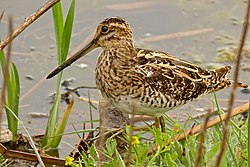| Snipe | |
|---|---|
 | |
| Common snipe (Gallinago gallinago) | |
| Scientific classification | |
| Kingdom: | Animalia |
| Phylum: | Chordata |
| Class: | Aves |
| Order: | Charadriiformes |
| Suborder: | Scolopaci |
| Family: | Scolopacidae |
| Groups included [1] | |
| Cladistically included but traditionally excluded taxa [1] | |
A snipe is any of about 26 wading bird species in three genera in the family Scolopacidae. They are distinguished by a very long, slender bill, eyes placed high on the head, and cryptic/camouflaging plumage. The snipes in the genus Gallinago have a nearly worldwide distribution, the genus Lymnocryptes is restricted to Asia and Europe, and the snipes in the genus Coenocorypha are now found only in the outlying islands of New Zealand. The genus Lymnocryptes is more closely related to woodcocks (Scolopax) than it is to other snipes; with woodcocks included, the four genera form a monophyletic group within the wider family Scolopacidae. [1] The three species of painted-snipe are not closely related to the typical snipes, and are placed in their own family, the Rostratulidae.

